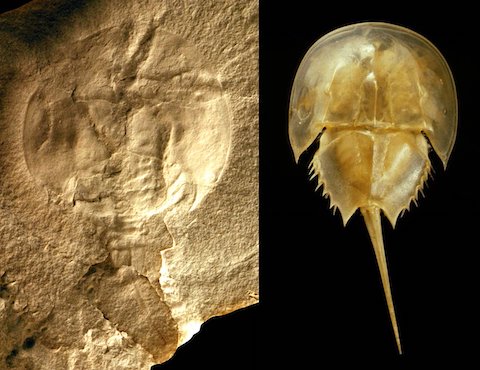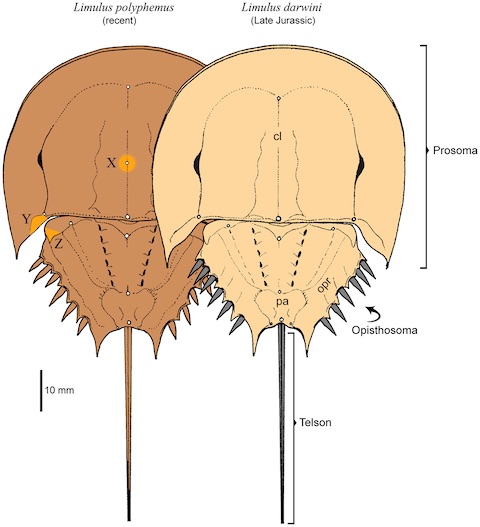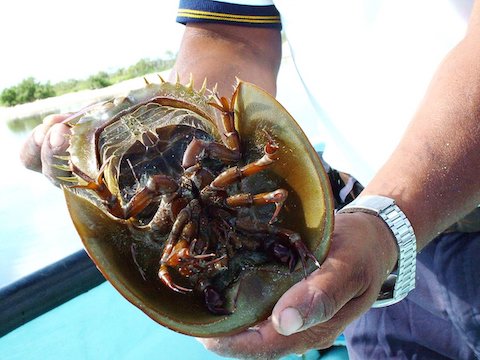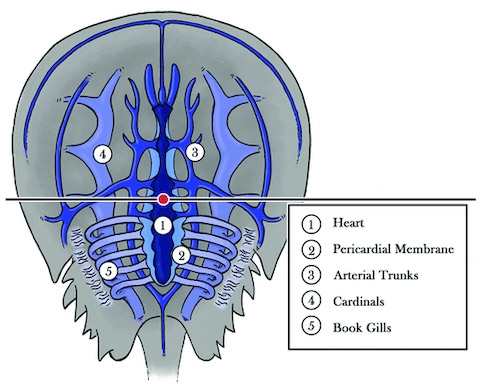
Credit: Dave Rudkin, Royal Ontario Museum, Toronto
The horseshoe crab is a living fossil—sometimes called a stabilomorph, a body design that evolution got so right, it hasn’t had to change.
They’ve been roaming the coastal shelves and brackish bays of Earth for more than 400 million years in nearly the identical form as today, having survived all five great extinction events we’ve discussed on EarthDate—including the asteroid that wiped out the dinosaurs.
Why are they so enduring? A few reasons:
They’re generalists that can live in shallow or deep, warm or cold water, and eat pretty much anything they find on the sea floor.
They breed very successfully, grow fairly quickly, and have long lives—typically 20 to 40 years.
And they’ve developed a unique and powerful immune system to keep them healthy.
Horseshoe crabs live in bacteria-rich environments yet have a primitive open circulation system that can be prone to infection.
So their blood—actually a blood-like substance called hemolymph—developed special cells that release granules when they detect even the tiniest concentration of pathogens or the toxins they can produce.
The granules cause the blood to coagulate into a gel around the intruders, trapping them and sealing them off from the rest of the crab’s system. It’s so effective, it can close off the wound from a lost limb, sealing out bacteria.
This capability has made the lowly horseshoe crab absolutely invaluable to human medicine, which we’ll discuss in another EarthDate.
Background
Synopsis: Most living things adapt over time, but horseshoe crabs found their perfect form more than 400 million years ago and haven’t needed to evolve much ever since. They are long-lived marine scavengers with a highly effective, yet primitive, immune system that has protected them through the eons.

Credit: Adrian Kin, Błażej Błażejowski (CC BY)
- Life continually evolves, adapting to the changing circumstances of environments over time, but there are a few exceptions that seem frozen in time—like organisms from the order Xiphosura’s only remaining family, Limulidae, the family of the horseshoe crab.
- These organisms are referred to colloquially as “living fossils,” but scientists call them stabilomorphs because they retain a stable form over long geological time frames. Their soft tissues may have evolved over time, but the parts that are preserved as fossils have kept the same characteristics.
- Horseshoe crabs are creatures of the Paleozoic Era that survived all five major extinction events including the Ordovician (444 Ma), Devonian (375 Ma), Permian (251 Ma), Triassic (200 Ma), and Cretaceous (66 Ma). We covered these extinctions in a previous EarthDate.
- The oldest fossils of horseshoe crabs, found in 445-million-year-old Ordovician rocks in Manitoba, Canada, look similar to the creatures we find living on beaches today.
- Younger 148-million-year-old Jurassic fossils from a Polish quarry have shapes and sizes virtually identical to today’s horseshoe crabs. When these fossil animals lived alongside the dinosaurs, their ancestors had already lived on Earth for about 300 million years.
- They have scrambled over Earth’s surface more than 1000 times as long as Homo sapiens have, and their niche for all this time has been nearshore brackish to marine shallow subtidal environments. They have evolved to be extremely well suited to these environments without the need for further adaptation, even as global temperatures, atmospheric CO2 levels, and ocean salinites have varied widely.
- Scientists are currently studying the horseshoe crab’s genome to try to understand how it has survived for so long, even through some of the direst times for life on Earth.
- Horseshoe crabs are not actually crabs—their closest relatives are arachnids like spiders, ticks, and scorpions.
- Horseshoe crabs and crabs are both arthropods: invertebrates with exoskeletons, segmented bodies, and jointed appendages. Insects, arachnids (spiders), centipedes, and crustaceans are all arthropods.
- Horseshoe crabs are most closely related to modern arachnids called hooded tickspiders and to the extinct giant arachnids known as sea scorpions.
- Today, there are four living species of horseshoe crabs in the family Limulidae: one native to the North American Atlantic and Gulf of Mexico coasts, and three that are indigenous to Indian and Pacific Ocean coastlines of Asia.

Credit: Angel Schatz (CC BY)
- As animals that completed most of their evolution during the Paleozoic Era, modern horseshoe crabs are very unusual creatures compared to most modern marine life.
- Their whole body is covered by a hard, shell-like carapace that is shed each year during molting.
- They respire through book gills located behind their legs but can live for up to 4 days out of the water as long as the gills are kept wet.
- Their mouths are surrounded by their twelve legs, of which the smallest pair is dedicated to sweeping food into the mouth. They eat algae, clams, crustaceans, worms, and other animals by crushing hard food between their legs before passing it to their mouths and gizzards for further grinding.
- The five larger pairs of legs are used for walking and swimming. Horseshoe crabs swim upside down at up to 0.3 miles (0.5 kilometers) per hour with their body at an angle of about 30 degrees, carapace headed forward to plow through the water.
- The tail, known as a telson, is long and straight, serving as a rudder during swimming and as a lever to help right the animal if it flips upside-down on land.
- Horseshoe crabs have two compound eyes with around 1000 photoreceptor units each and another pair of eyes that can see both the visible spectrum and ultraviolet light. They have several other rudimentary eyes that are simple photoreceptors, including some on their tail.
- They are extremely light sensitive. Their rods and cones are 100 times the size of those in humans, making their eyes a million times more sensitive to light at night than during the day.
- In the wild, horseshoe crabs live for 20 to 40 years. Adults of the North American species can weigh about 10 lb (4.5 kg) with bodies that are 1 ft (30 cm) in diameter with a foot-long telson.

Credit: Jordan Krisfalusi-Gannon
- In the closed circulatory system of humans, iron-based hemoglobin carries oxygen to tissues and organs through closed blood vessels. But horseshoe crabs have primitive open circulatory systems, which distribute a blood-like substance called hemolymph.
- A protein called hemocyanin is suspended in the hemolymph and carries oxygen to the horseshoe crab’s tissues. The hemocyanin is copper-based, which gives oxygenated hemolymph a blue color. This is because when copper atoms are exposed to oxygen, they turn blue. Our blood is red for a similar reason—iron becomes bright red when exposed to oxygen.
- Instead of closed blood vessels that supply blood to their tissues, horseshoe crabs have circulatory sinuses that bathe their tissues directly in blood.
- It would be fatal to the horseshoe crab if the pathogens so abundant in coastal waters were to breach these sinuses. So Limulidae developed an immune response to certain types of both live bacteria and the endotoxins released when these bacteria die and disintegrate.
- When these materials are detected in the horseshoe crab’s system, nearby amoebocytes immediately eject granules that cause the blue blood to coagulate instantly, surrounding the foreign cells and sealing any leaks in the circulatory system with a thick gel. The gel serves as a scab-like barrier that holds even in the event a limb is severed.
- This has important implications for human health, as we will describe in another EarthDate episode.

